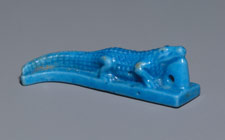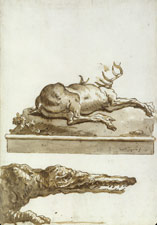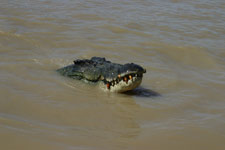New Connections appear every Wednesday. Sign up for a reminder.
Oceanic art curator Eric Kjellgren dissects the myths and urban legends associated with the crocodile throughout the ages.
 1280852
1280852 12671024
12671024 1280897
1280897 1280331
1280331 1280495
1280495 1280795
1280795 4671024
4671024 8091024
8091024 1280977
1280977 1280978
1280978 12081024
12081024 7151024
7151024 1280910
1280910 1280696
1280696 1280964
1280964 1280870
1280870 1280936
1280936 4701024
4701024 1280846
1280846 1280799
1280799 6831024
6831024 1280764
1280764 1280853
1280853 1280852
1280852
My name is Eric Kjellgren and I'm the curator of Oceanic art here at the Metropolitan, and I'm gonna talk today about crocodiles.
When I was a young child, I only got a chance to see alligators and crocodiles in zoos. My first chance to see them in the wild came when we did this traditional
family vacation to Florida, and there was a lake that seemed to be full of old logs. I thought, you know, "gosh I wish I
could see an alligator." And then as I stood at the shore, luckily not very close to it, I realized that every one of those was actually an alligator.
I was both thrilled and a little frightened of this, and I think that actually is something that endures with me even today. New York has its own
crocodilian mythology about alligators living in the sewers. And in some stories, they were supposed to lose all the
pigmentation in their skin and become essentially albino crocodiles, ten feet long, surviving on rats, garbage, and the occasional sewer worker. Fortunately
according to herpetologists, there doesn't seem to be much basis in fact for this, but there was actually a number of years ago
somebody released a caiman into the Harlem Meer, not very far from the Museum now.
You often see crocodiles in these allegorical representations associated either with America, in which case you're seeing alligators, or with Africa, in which case you're seeing crocodiles. This includes America personified as this woman with this great flowing headdress
but just behind her right leg you can see this alligator peeking out. Most of the images before the nineteenth century
are drawn either from stuffed specimens or from other illustrations.
This poor crocodile looks like it was among the most shriveled-up, dried-out natural history specimens in the local museum or noble's collection.
Crocodilians have a very sort of distinctive body shape. It's at once sort of, you know, beautifully flowing sinuous curves, but also a ruggedness.
This watercolor by John Singer Sargent impresses me by the way he's able to render
the shape of an alligator just with a sort of almost amorphous blob of paint.
This crocodile bag actually reminds me very much of my grandmother, who was not a fan of crocodiles or alligators. And I remember watching television with her once about alligators, which of course I thought was fascinating. She said, "Well, you know, I wouldn't mind at all if these things went extinct 'cause I think they're nasty creatures."
These were used as part of an initiation ceremony. You bring the instrument down vertically on the water, and this makes a sound sort of like, "kabooyzhee, kabooyzhee." And that noise was said to be the noise of young men being swallowed by this giant crocodile.
If I was at the zoo and I snapped that photograph on my digital camera, I'd probably just hit the delete key 'cause I didn't get the head, and yet, here I think it is in fact one of the best crocodiles images that I've seen. You see their role as a dangerous, hidden thing.
I've tried to convert some people to my fascination with crocodiles, and actually somewhat succeeded with my wife.
And we actually went on our honeymoon in Australia and took a crocodile watching trip.
They tap things on the water to attract the crocodiles and feed them meat so they'll come out to the boat. And this is all very well because it let's you see the crocodiles, but it also reminds you that these crocodiles associate the boat with food, so that it's wise not to fall out of it if you can avoid it.
Part of the whole sort of mystique and attraction of crocodiles is the fact that they're also dangerous creatures. You could potentially be eaten, not a part
I'd really like to experience.
 |
 |
 |
 |
 |
 |
 |
 |
 |
 |
 |
 |
 |
 |
 |
 |
 |
Works of art in order of appearanceLast Updated: June 22, 2015. Not all works of art in the Museum's collection may be on view on a particular day. For the most accurate location information, please check this page on the day of your visit. |
||
 |
Jardin des Plantes 1898–1900 Eugène Atget (French) Albumen silver print from glass negative Gilman Collection, Museum Purchase, 2005 (2005.100.542) More information: The Collection Online Not on view
|
 PhotographsSecond Floor
PhotographsSecond Floor |
 |
[Five 35mm Film Frames on Uncut Roll of Roadside Stand Selling Shells and Advertising Live Alligators, Tarpon Springs, Florida] December 1941 Walker Evans (American) Film negative Walker Evans Archive, 1994 (1994.253.462.1–5) More information: The Collection Online Not on view
|
 PhotographsSecond Floor
PhotographsSecond Floor |
 |
Mi-gyaung late 19th century Myanmar (formerly Burma) The Crosby Brown Collection of Musical Instruments, 1889 (89.4.1473) More information: The Collection Online Not on view
|
 Musical InstrumentsSecond Floor
Musical InstrumentsSecond Floor |
 |
Canoe Prow 19th–early 20th century Iatmul people; Papua New Guinea, Mindimbit village, Middle Sepik River Wood, cowrie shells The Michael C. Rockefeller Memorial Collection, Purchase, Nelson A. Rockefeller Gift, 1955 (1978.412.705) More information: The Collection Online Not on view
|
 Arts of Africa, Oceania, and the AmericasFirst Floor
Arts of Africa, Oceania, and the AmericasFirst Floor |
 |
Sobek as a crocodile Early Ptolemaic Period (ca. 304–247 b.c.) Egyptian Faience Gift of Norbert Schimmel Trust, 1989 (1989.281.96) More information: The Collection Online Not on view
|
 Egyptian ArtFirst Floor
Egyptian ArtFirst Floor |
 |
Painting from a Ceremonial House Ceiling 1970 Numei, Amachi Kalaba Sago palm spathe, paint The Michael C. Rockefeller Memorial Collection, Purchase, Mrs. Gertrud A. Mellon Gift, and Mr. and Mrs. Alan Brandt Gift in memory of Jacob J. Brandt, 1974 (1978.412.1658) More information: The Collection Online Not on view
|
 Arts of Africa, Oceania, and the AmericasFirst Floor
Arts of Africa, Oceania, and the AmericasFirst Floor |
 |
Crocodile Reading ca. 1891 Oliver Herford (American) Graphite, brush, and India ink Gift of Ethel Watts Grant, 1939 (39.41.8) More information: The Collection Online Not on view
|
 Drawings and PrintsSecond Floor
Drawings and PrintsSecond Floor |
 |
Double Crocodile Pendant 8th–10th century Panama; Macaracas Gold, quartz The Michael C. Rockefeller Memorial Collection, Bequest of Nelson A. Rockefeller, 1979 (1979.206.733) More information: The Collection Online Not on view
|
 Arts of Africa, Oceania, and the AmericasFirst Floor
Arts of Africa, Oceania, and the AmericasFirst Floor |
 |
America 18th century Giovanni Domenico Tiepolo (Italian) Fresco, transferred to canvas Bequest of Grace Rainey Rogers, 1943 (43.85.20) More information: The Collection Online Not on view
|
 European PaintingsSecond Floor
European PaintingsSecond Floor |
 |
A Stag Lying Down (on a base): The Head of a Crocodile after 1770 Domenico Tiepolo (Italian) Pen and brown ink, brown wash, over traces of black chalk Robert Lehman Collection, 1975 (1975.1.521) More information: The Collection Online Not on view
|
 The Robert Lehman CollectionFirst Floor
The Robert Lehman CollectionFirst Floor |
 |
Crocodile Rattle 8th century Maya Ceramic The Michael C. Rockefeller Memorial Collection, Bequest of Nelson A. Rockefeller, 1979 (1979.206.1143) More information: The Collection Online Not on view
|
 Arts of Africa, Oceania, and the AmericasFirst Floor
Arts of Africa, Oceania, and the AmericasFirst Floor |
 |
Alligators 1917 John Singer Sargent (American) Watercolor, graphite, and wax crayon on white wove paper Gift of Mrs. Francis Ormond, 1950 (50.130.63) More information: The Collection Online Not on view
|
 American Paintings and SculptureFirst and Second Floors
American Paintings and SculptureFirst and Second Floors |
 |
Satchel first quarter 20th century American Leather, metal Brooklyn Museum Costume Collection at The Metropolitan Museum of Art, Gift of the Brooklyn Museum, 2009; Gift of James J. Freeman, 1963 (2009.300.1547) More information: The Collection Online Not on view
|
 Arts of Africa, Oceania, and the AmericasFirst Floor
Arts of Africa, Oceania, and the AmericasFirst Floor |
 |
Water Drum 19th–early 20th century Papua New Guinea, Middle Sepik region, Mindimbit village, Iatmul people Wood, fiber The Michael C. Rockefeller Memorial Collection, Bequest of Nelson A. Rockefeller, 1979 (1979.206.1627) More information: The Collection Online Not on view
|
 Arts of Africa, Oceania, and the AmericasFirst Floor
Arts of Africa, Oceania, and the AmericasFirst Floor |
 |
[Crocodile] 1978 Joan Fontcuberta (Spanish) Gelatin silver print Gift of the artist, 1978 (1978.610.1) More information: The Collection Online Not on view
|
 PhotographsSecond Floor
PhotographsSecond Floor |
 |
Crocodile statue Ptolemaic or Roman Period, 304 b.c.–364 a.d. Italy, Southern Europe, Rome Granite Purchase, The Bernard and Audrey Aronson Charitable Trust Gift, in memory of her beloved husband, Bernard Arnonson, 1992 (1992.13) More information: The Collection Online Not on view
|
 Egyptian ArtFirst Floor
Egyptian ArtFirst Floor |
 |
Masquerade Element: Crocodile Head (Omama) 17th–19th century Yoruba peoples, Owo group Nigeria Ivory, wood or coconut shell inlay Gift of Mr. and Mrs. Klaus G. Perls, 1991 (1991.17.125) More information: The Collection Online Not on view
|
 Arts of Africa, Oceania, and the AmericasFirst Floor
Arts of Africa, Oceania, and the AmericasFirst Floor |
© 2011 The Metropolitan Museum of Art |
||






